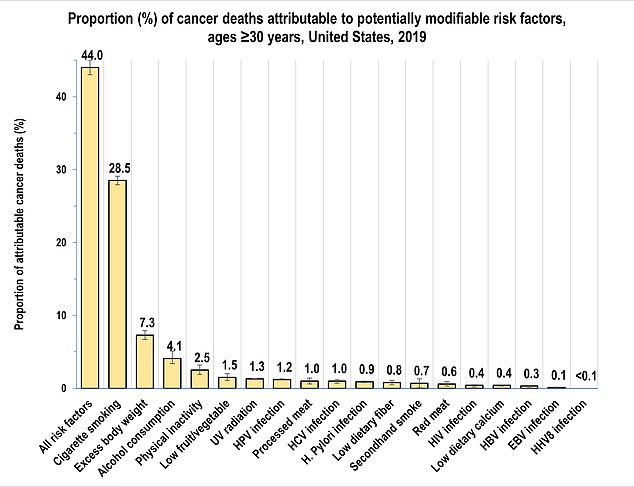Nearly half of cancer deaths in the United States can be attributed to six decisions people make in their daily lives.
According to a new report published The American Cancer Society, forOne in 10 cancer cases and nearly half of cancer deaths in Americans over age 30 are linked to smoking, being overweight, alcohol consumption, inactivity, poor diet and too much sun.
Other factors, such as exposure to secondhand smoke, red meat consumption, unprotected sex leading to HPV or HIV infection, and a low-calcium diet, were also identified as causing several cases of cancer, but they caused a fraction of cases compared to the six main categories.
Despite anti-smoking campaigns and a downward trend in tobacco use, cigarettes remain the leading cause of cancer in the United States, accounting for 20 percent of all new cancer cases and 30 percent of all cancer deaths in 2019.
“The number of lung cancer deaths attributable to smoking in the United States is alarming,” said Dr. Farhad Islami, study author and senior scientific director of cancer disparities research at the American Cancer Society.
A new report from the American Cancer Society analyzed cancer cases in 2019 and found that 44 percent of that year’s deaths could be attributed to behaviors people engaged in over their lifetime.

Cigarette smoking was the biggest contributor to cancer cases and deaths in 2019, the year the ACS studied. Other risk factors included alcohol consumption, nutrition, physical activity and infections, such as HPV.
After cigarettes, the highest number of cancers was attributed to excess body weight, alcohol consumption, sun damage and physical inactivity.
The authors did not define excess body weight, but they likely relied on the body mass index, a standard used by American doctors that places patients into four categories based on their height and weight: underweight, normal weight, overweight and obese.
Excess body weight may include people in both the overweight and obese categories, or it may include only obese people.
The researchers also did not specify the amounts of alcohol consumed by the people included in the study. However, U.S. Centers for Disease Control and Prevention defines regular alcohol consumption as two drinks a day for men and one drink a day for women.
However, they recommend drinking less and say the safest thing to do is to avoid drinking altogether.
Dr Islami said the results highlighted the importance of educating people about quitting smoking and getting proper nutrition and exercise.
“Interventions to help maintain a healthy body weight and diet can also substantially reduce the number of cancer cases and deaths in the country,” said Dr Islami.
According to the NIH, about seven in ten Americans are overweight or obese, a number that has been steadily increasing since the 1970s.
Doctors believe that excess body fat alters the way the body regulates hormones and inflammation, which can lead to an increased risk of cancer by changing the natural life cycle of cells. Dr. Karen Basen-Engquistprofessor of behavioral sciences at MD Anderson, who was not involved in the study.
This carries an increased risk of colorectal, breast, uterine, esophageal, kidney and pancreatic cancer.
In 2019, there were 713,340 cases of cancer diagnosed in Americans over age 30 and 262,120 deaths from cancer, according to the report, which was published in CA: A cancer journal for physicians.
Nineteen percent of new diagnoses, representing 344,070 people, were attributable to smoking.
Thirty percent of deaths, or approximately 169,810, were caused by smoking.
Excess body weight was responsible for 135,910 new cases and 43,520 deaths in people over 30 years of age in 2019.
Alcohol consumption was responsible for 96,730 new cases and 24,410 deaths in people over 30 years of age in 2019.
Close behind are cancers caused by a sedentary lifestyle, poor diet, sun exposure and human papillomavirus (HPV) infections.
HPV is a sexually transmitted disease linked to cancers of the cervix, throat, mouth and anus, and causes more cancers than factors such as eating a diet high in processed meat, the study found.
The disease is commonly transmitted through unprotected vaginal, anal, and oral sex.
This revealed a “continued need” to raise awareness about the HPV vaccine, which is highly effective at preventing STIs, said study author Dr. Ahmedin Jemal.
“Vaccination at the recommended time can substantially reduce the risk of chronic infection and, consequently, cancers associated with these viruses,” said Dr. Jemal, senior vice president of health equity surveillance and science at the American Cancer Society.
Not all cancers are easily attributed to risk factors such as those described in the study. Therefore, the researchers focused on those that had a clear relationship with behaviours, such as lung cancer, melanoma and colorectal cancer.
To reach these conclusions, the researchers did not survey all American households.
Instead, they used data available from the National Cancer Institute’s Surveillance, Epidemiology, and End Results Program, which tracks cancer cases nationwide.
The report stressed the importance of raising awareness about these risk factors and said it is still possible to begin educating people and “substantially reduce” cancer cases and deaths in the country.


